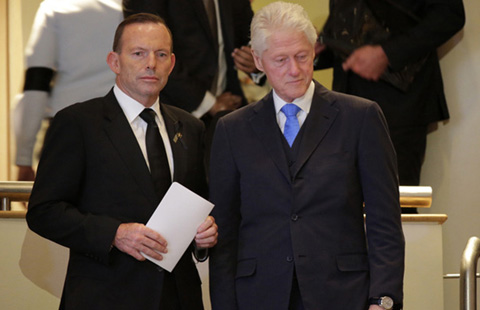New York will remain focus of investors: experts
Updated: 2015-03-30 06:22
By PAUL WELITZKIN In New York(China Daily USA)
|
||||||||
As the Chinese increase real-estate investments in the United States, they are likely to continue to focus on major cities and metropolitan areas like New York, according to real estate industry professionals.
"I expect the Chinese to continue to focus on the gateway cities like New York, Los Angeles and San Francisco," said Michael Krupa, president of Gemdale USA, a unit of one of Asia's largest real-estate companies. "Those areas have and are likely to maintain strong fundamentals."
He made his comments at the 8th annual China Business Conference at Columbia University in New York on March 27. Krupa was part of a panel that explored the topic A Tidal Wave of Chinese Real Estate Investment.
Moderator Leanne Lachman, president of Lachman Associates, an independent real estate consulting company, noted that more than $40 billion of Chinese money has gone into commercial real estate with one-third in the US and most of that in New York City.
Omer Ozden, executive director of XIN Development, the US development arm of Xinyuan Real Estate Co Ltd, described a company development in the Williamsburg section of Brooklyn involving luxury condominiums. "We are building luxury for the local market and have sold over 70 percent of our units to local buyers," he said.
Ozden said XIN will continue to target New York and the other gateway cities. "I believe the Chinese will focus on these areas for at least the next 5-7 years" before turning their attention to other US areas.
Familiarity and the promise of a safe haven will keep Chinese money flowing into US real estate, said Dan Weil, CEO of Salmon Run Capital. "If the world is getting funky where do you want to put your money? The US is a safe investment haven," he said.
"New York City has and will remain the No 1 city for foreign real estate investment," added Louis Katsos, president of Jekmar Associates Inc, a consulting and development consulting company.
Lachman noted that the members of the panel are all "white (Caucasian) men," and then asked how they have fared in Chinese and Asian circles. "The Chinese need to build trust and they need to find people they are comfortable with so I focus on that," said Jeffrey Dvorett, executive vice-president and head of development for Kuafu Properties. He also said they appreciate competence in a specific area. "We know how New York real estate operates and that's what we emphasize."
In the future, Weil believes that the panel will be much more diverse. "Most of you (referring to the large number of Chinese students in attendance) will be taking our place and that's the way it should be. You will have the knowledge and skills to compete."
Lachman asked how this wave of heavy commercial real estate investing can avoid the same fate that befell the Japanese in the late 1980s and early 1990s.
"It's a different time period now," Katsos said. "The Chinese know that as the world gets more dangerous capital is coming to the US and especially New York City."
"The transparency of information due to the Internet will help the Chinese to make better decisions," said Dvorett.
Panel members also discussed the EB-5 visa program in the US. Lachman said that approximately 85 percent of EB-5 funds come from China. EB-5 is an alternative way for immigrant investors to obtain a US visa. It was created in 1990 to help stimulate the economy through job creation and foreign investment. With a minimum of $1 million — or $500,000 in low employment or rural areas — an EB-5 investor must create at least 10 full-time jobs through the project they are working toward completing. In return, the investor is eligible for permanent US residency.
"The bulk of EB-5 is for students whose parents are trying to buy them a chance to go to school in America," said Weil. "New York and California are biggest locations for EB-5 funding mainly because they were the first to take advantage of it.
"Don't expect this (EB-5) to continue forever," he continued. "I see this going on for another five years or so but eventually it will end."
paulwelitzkin@chinadailyusa.com

 Students show support for Earth Hour
Students show support for Earth Hour
 Sleep with fish at Tianjin aquarium
Sleep with fish at Tianjin aquarium
 Moments of beauty and strength at ISU figure skating worlds
Moments of beauty and strength at ISU figure skating worlds
 Pier Antique Show in New York
Pier Antique Show in New York
 Rio bay won't be clean for sailing: organizers
Rio bay won't be clean for sailing: organizers
 Tech tycoons' take on innovation in BFA
Tech tycoons' take on innovation in BFA
 World dignitaries at state funeral of Lee Kuan Yew
World dignitaries at state funeral of Lee Kuan Yew
 Sandstorm shrouds Beijing
Sandstorm shrouds Beijing
Most Viewed
Editor's Picks

|

|

|

|

|

|
Today's Top News
China, US 'cannot afford' maritime dispute
Focus shifts to cause of NYC explosion after 2 bodies found
Warship arrives to evacuate Chinese nationals from Yemen
China-US 'new diplomacy' discussed
'Belt and road' blueprint boosts practical cooperation
China eyes $2.5 tln annual trade volume with Belt and Road countries
Chinese Vice President attends Lee Kuan Yew's funeral
Youku Tudou faces class
action lawsuit
US Weekly

|

|







